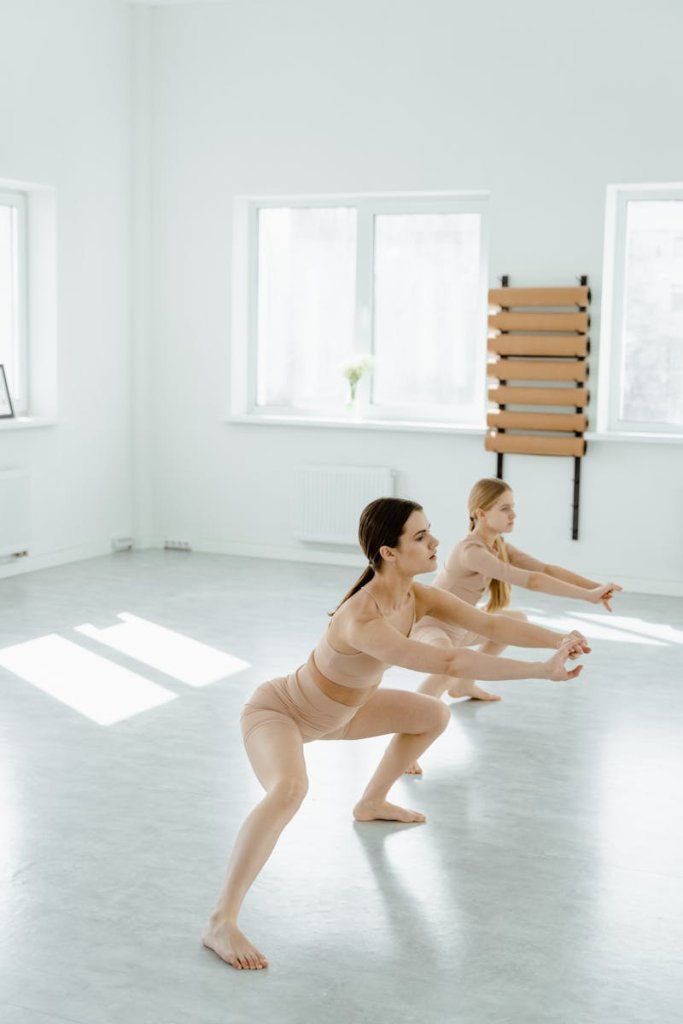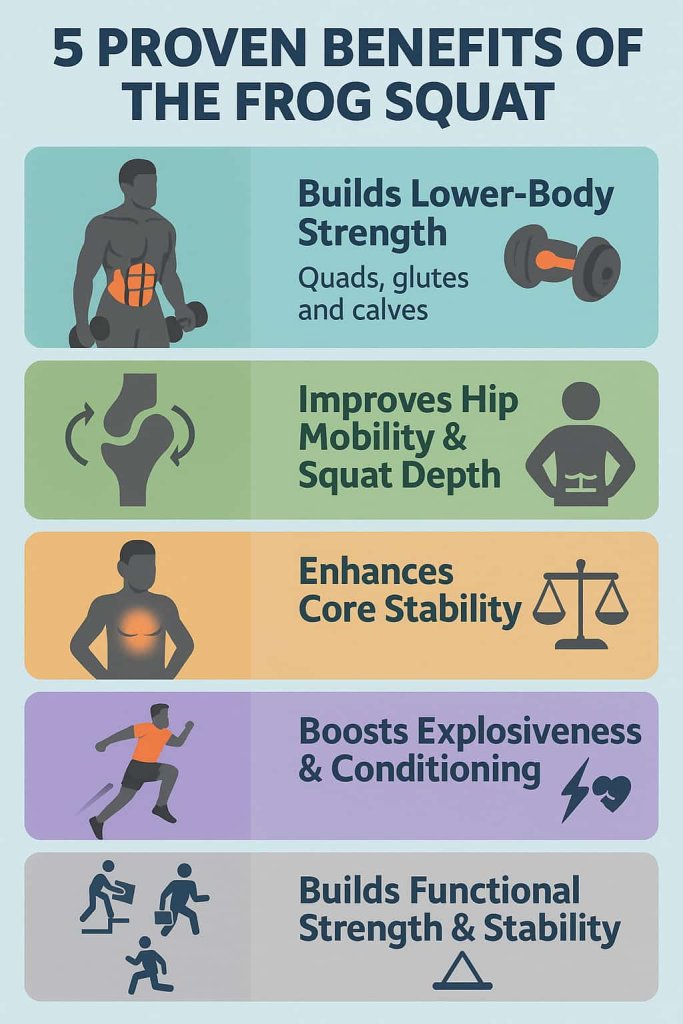The frog squat is one of the best lower-body exercises for improving strength, mobility, and flexibility while reducing injury risk. Unlike standard squats, the frog squat uses a wide stance with toes pointed outward, which emphasizes hip mobility, inner thigh activation, and balance.

This exercise is particularly valuable if you struggle with tight hips or shallow squat depth. By practicing frog squats regularly, you can unlock deeper range of motion, build stronger quads and glutes, and even enhance core stability.
Whether you’re a beginner or an experienced lifter, frog squats can transform your squat performance and overall fitness.
What Is a Frog Squat?
A frog squat is a wide-stance squat variation where your toes point outward and you lower into a deep squat with your chest upright. It can be performed with bodyweight, dumbbells, kettlebells, or progressed into jumps for explosiveness.
Unlike a regular squat, frog squats often use partial reps (not standing up fully) to maintain constant tension on the muscles. They are also used in yoga and athletic training to improve mobility, balance, and hip opening.
5 Proven Benefits of the Frog Squat

1. Builds Lower-Body Strength
Frog squats train multiple muscles at once, including:
- Quadriceps – drive knee extension
- Glutes – support hip extension
- Hamstrings – stabilize knee and hip movement
- Adductors (inner thighs) – activated more due to the wide stance
- Calves – help with balance and support
Experts note that frog squats are effective for strengthening both major and supporting muscles, making them a compound movement ideal for functional strength.
2. Improves Hip Mobility and Squat Depth
Many people struggle with achieving full squat depth because of tight hips or limited mobility. The frog squat helps correct this by:
- Forcing the hips into external rotation
- Stretching the groin and adductors
- Allowing the torso to remain upright while descending deeper
Note that frog squats aren’t just for strength—they’re also an excellent mobility drill, particularly for those aiming to achieve full ass-to-grass squats.
3. Enhances Core Stability
Unlike some squat variations, frog squats require you to stay upright. This forces your core, obliques, and spinal erectors to engage more actively.
- Holding a dumbbell in goblet style makes this effect stronger.
- Improved core strength means better posture, balance, and injury prevention in everyday movements.
4. Boosts Explosiveness and Conditioning
Adding a jump to frog squats turns them into a plyometric exercise. Trainers highlight that frog squat jumps build explosiveness, power, and cardiovascular endurance, making them perfect for athletes, runners, and HIIT workouts.
Benefits of plyometric frog squats include:
- Training fast-twitch fibers for sprinting and jumping
- Improving vertical jump and agility
- Increasing calorie burn and cardiovascular conditioning
5. Builds Functional Strength and Stability
Frog squats aren’t just for looks—they improve real-world movement patterns. Reddit users have reported better hip stability, balance, and squat depth after incorporating frog squats into their routine.
Functional strength from frog squats helps with:
- Climbing stairs
- Lifting heavy objects safely
- Athletic movements like sprinting, cutting, and jumping
- Preventing falls and improving balance
How to Do the Frog Squat Properly
Step-by-Step Guide
- Starting Position:
- Stand with feet wider than shoulder-width apart.
- Point toes outward at about a 30–45° angle.
- Brace the Core:
- Keep chest tall, back neutral, and shoulders back.
- Engage your abs before lowering.
- Descend into Squat:
- Push hips back and bend knees.
- Lower until thighs are parallel or deeper, keeping heels flat.
- Partial Ascent:
- Rise only halfway up instead of locking out fully.
- This keeps constant tension on the quads and glutes.
- Controlled Reps:
- Perform 10–15 reps per set.
- Inhale on the way down, exhale on the way up.
Trainer Tips for Better Form
- Keep knees aligned with toes to prevent joint stress.
- Avoid leaning too far forward—stay upright.
- Place weight on heels, not toes.
- Warm up hips before starting with mobility drills like hip openers.
Variations of the Frog Squat
1. Bodyweight Frog Squat
How to Perform:
- Stand with feet wider than shoulder-width, toes pointing outward.
- Lower into a deep squat, placing elbows inside the knees for support.
- Keep chest upright and hips dropped low.
- Return to standing by driving through the heels.
Muscles Worked: Quads, glutes, adductors, hamstrings, and core.
Best For: Beginners learning squat depth, mobility, and hip opening.
Trainer Tip: Focus on driving knees outward with elbows to open the hips.
2. Goblet Frog Squat
How to Perform:
- Hold a dumbbell or kettlebell close to your chest (goblet position).
- Drop into a frog squat with elbows inside knees.
- Keep core tight and chest tall throughout the movement.
Muscles Worked: Quads, glutes, inner thighs, core, and upper body stability.
Benefits: Adds resistance to build strength while reinforcing posture.
Trainer Tip: Start light (10–20 lbs) and gradually increase weight once form is mastered.
3. Barbell Frog Squat
How to Perform:
- Set a barbell across your upper back (like a back squat).
- Take a wide stance with toes out.
- Descend into a deep frog squat, pushing hips down and knees outward.
- Drive back up with controlled power.
Muscles Worked: Quads, glutes, hamstrings, spinal erectors, and traps.
Best For: Intermediate to advanced lifters seeking strength gains.
Trainer Tip: Keep core braced to protect the spine; avoid letting knees cave inward.
4. Frog Squat Pulses
How to Perform:
- Get into the bottom of a frog squat.
- Instead of standing up fully, perform small up-and-down pulses.
- Maintain tension in quads and glutes throughout.
Muscles Worked: Quads, glutes, adductors.
Benefits: Builds endurance, burns muscles out, and improves time-under-tension.
Trainer Tip: Use bodyweight first, then add a light dumbbell for progression.
5. Frog Jumps
How to Perform:
- Start in frog squat stance.
- Explosively jump up, swinging arms for momentum.
- Land softly back in squat position, repeating immediately.
Muscles Worked: Quads, calves, glutes, core.
Best For: Athletes, fat-burning circuits, and explosive power.
Trainer Tip: Land quietly to protect knees and ankles; keep reps short (8–12) for max effect.
Common Mistakes to Avoid
- Letting knees cave inward → can cause knee strain.
- Rounding the back → increases risk of injury.
- Not going deep enough → limits benefits for mobility and strength.
- Locking out at the top → reduces constant muscle tension.
Programming: How to Add Frog Squats to Your Workout
- Beginners: 3 sets of 10–12 bodyweight reps, 2–3x/week
- Intermediate: 3–4 sets of 12–15 goblet squats with dumbbell
- Advanced: 3–5 sets of 8–12 weighted barbell squats or 10 explosive jumps
Use them as a:
- Warm-up drill for mobility
- Accessory exercise on leg day
- Finisher with jumps for conditioning
FAQs About Frog Squats
1. Do frog squats build muscle?
Yes. They target quads, glutes, and inner thighs, especially when weighted.
2. Are frog squats good for flexibility?
Absolutely—they stretch hips and groin while building strength.
3. Can I replace regular squats with frog squats?
Not fully. Frog squats complement regular squats by improving mobility and inner thigh activation.
4. Do frog squats burn fat?
Yes, especially if done as frog jumps, which increase heart rate and calorie burn.
5. Can people with knee pain do frog squats?
Yes, if done carefully. Keep knees aligned with toes and avoid heavy loads at first. Always consult a professional if pain persists.
6. How many days per week should I do frog squats?
2–3 times per week is ideal for strength and mobility without overtraining.
7. Are frog squats good for athletes?
Yes. Frog squat jumps improve explosive power, agility, and sports performance.
Conclusion
The frog squat is more than just a squat variation—it’s a powerful movement for strength, mobility, and athletic performance. By practicing regularly, you’ll strengthen your lower body, improve hip flexibility, activate your core, and even boost explosive power.
✅ Whether you’re chasing better squat depth, stronger legs, or improved balance, frog squats deserve a place in your training. Add them today and feel the difference in both performance and daily movement.
